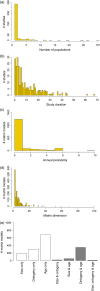COMADRE: a global data base of animal demography
- PMID: 26814420
- PMCID: PMC4819704
- DOI: 10.1111/1365-2656.12482
COMADRE: a global data base of animal demography
Abstract
The open-data scientific philosophy is being widely adopted and proving to promote considerable progress in ecology and evolution. Open-data global data bases now exist on animal migration, species distribution, conservation status, etc. However, a gap exists for data on population dynamics spanning the rich diversity of the animal kingdom world-wide. This information is fundamental to our understanding of the conditions that have shaped variation in animal life histories and their relationships with the environment, as well as the determinants of invasion and extinction. Matrix population models (MPMs) are among the most widely used demographic tools by animal ecologists. MPMs project population dynamics based on the reproduction, survival and development of individuals in a population over their life cycle. The outputs from MPMs have direct biological interpretations, facilitating comparisons among animal species as different as Caenorhabditis elegans, Loxodonta africana and Homo sapiens. Thousands of animal demographic records exist in the form of MPMs, but they are dispersed throughout the literature, rendering comparative analyses difficult. Here, we introduce the COMADRE Animal Matrix Database, an open-data online repository, which in its version 1.0.0 contains data on 345 species world-wide, from 402 studies with a total of 1625 population projection matrices. COMADRE also contains ancillary information (e.g. ecoregion, taxonomy, biogeography, etc.) that facilitates interpretation of the numerous demographic metrics that can be derived from its MPMs. We provide R code to some of these examples.
Synthesis: We introduce the COMADRE Animal Matrix Database, a resource for animal demography. Its open-data nature, together with its ancillary information, will facilitate comparative analysis, as will the growing availability of databases focusing on other aspects of the rich animal diversity, and tools to query and combine them. Through future frequent updates of COMADRE, and its integration with other online resources, we encourage animal ecologists to tackle global ecological and evolutionary questions with unprecedented sample size.
Keywords: animal population ecology; comparative approach; matrix population model; open-data; population growth rate (λ).
© 2016 The Authors. Journal of Animal Ecology published by John Wiley & Sons Ltd on behalf of British Ecological Society.
Figures



References
-
- Altwegg, R. , Dummermuth, S. , Anholt, B.R. & Flatt, T. (2005) Winter weather affects asp viper Vipera aspis population dynamics through susceptible juveniles. Oikos, 110, 55–66.
-
- Barraquand, F. , Høye, T.T. , Henden, J.‐A. , Yoccoz, N.G. , Gilg, O. , Schmidt, N.M. et al (2014) Demographic responses of a site‐faithful and territorial predator to its fluctuating prey: long‐tailed skuas and arctic lemmings. Journal of Animal Ecology, 83, 375–387. - PubMed
-
- Baxter, P.W.J. , McCarthy, M.A. , Possingham, H.P. , Menkhorst, P.W. & McLean, N. (2006) Accounting for management costs in sensitivity analyses of matrix population models. Conservation Biology, 20, 893–905. - PubMed
Publication types
MeSH terms
LinkOut - more resources
Full Text Sources
Other Literature Sources
Molecular Biology Databases
Miscellaneous

